Shallow Crustal Structure of S-Wave Velocities in the Coastal Area of South China Constrained by Receiver Function Amplitudes
Abstract
:1. Introduction
2. Data and Methods
2.1. Geological Setting
2.2. Method of the Direct Wave Amplitude of the Receiver Function
2.3. Method of the SWV
2.4. Depth and Alpha
2.5. Data Processing Procedures
- (i)
- Events with epicentral distances of 30° to 90° and M ≥ 5.5 are selected from the continuous waveform data. Waveforms with high signal-to-noise ratios and clear initial motions are extracted and preprocessed for filtering, deburring, mean value removal, and linear trend removal, among others.
- (ii)
- Based on the earthquake azimuth, the waveform from the N-E-Z component is rotated to the R-T-Z component. Then, the data from 20 s before to 150 s after the initial P-wave movement are intercepted. Gaussian filter factors are selected (such as alpha = 1.0, 1.5, 2.5, 3, 5, and 7) in order to filter the signal of all stations. The receiver function is calculated by the time domain deconvolution method and filtering process.
- (iii)
- Using the vertical component of the receiver function to deconvolute itself, its maximum amplitude value is obtained to unify the radial receiver function, in order to obtain the absolute amplitude [15].
- (iv)
- Direct wave amplitudes of receiver functions at different stations in different directions are measured as observation values (Aobs). For each Vs0, the theoretical value (Asyn) of the direct wave amplitude is calculated using Equation (1). The smallest value of the misfit (Vs0) corresponds to the optimal solution of the Vs0. Finally, the SWV near the surface of the area is obtained.
- (v)
- In order to improve the signal-to-noise ratio, receiver functions of different epicentral distances are evenly distributed in 60° epicentral distance units, while receiver functions in each unit are superposed into every 1° grid size. Figure 4a shows the superposition results of multiple receiver functions at different epicentral distances obtained by the DNB station, with a high signal-to-noise ratio and clear seismic phases. Figure 4c shows the SWV Vs0 = 3.21 ± 0.22 km/s of the DNB station, with a percentage error of δ = 6.8%. Figure 4b,d show the superposition results of multiple receiver functions at different epicentral distances from the YGX station, with Vs0 = 2.78 ± 0.21 km/s and δ = 7.5%.
3. Results
3.1. Spatial Distribution of the SWV
3.2. SWV Distribution with Depth
4. Discussion
5. Conclusions
- (i)
- We propose a method of using the amplitude of the receiver function to obtain the SWV that corresponds to the Gaussian filter factor. This method is stable, economical, environmentally friendly and efficient, while comparing with the active source surveying in the upper crust. Meanwhile, the accuracy and separation rate of this method need more numerical experiments and data processing to verify, especially in the area with complex velocity structure.
- (ii)
- In the study area, we deduce that the low SWV in most sub-areas can be interpreted as the joint effect of the sedimentary layer of the alluvial plain and the accumulation of underground heat flows, in addition to multistage fracturing tectonism. The gradual change in the SWV in each profile from the surface to approximately 10 km is correlated with multiple invasions and the coverage of volcanic rocks to a certain extent, indicating weathering layer coverage and structural transformations between multistage intrusive rocks in the CASC.
Author Contributions
Funding
Data Availability Statement
Acknowledgments
Conflicts of Interest
References
- Gilder, S.A.; Gill, J.; Coe, R.S.; Zhao, X.X.; Liu, Z.W.; Wang, G.X. Isotopic and paleomagnetic constraints on the Mesozoic tectonic evolution of south China. J. Geophys. Res. Solid Earth 1996, 101, 16137–16154. [Google Scholar] [CrossRef]
- Xia, S.; Zhao, M.; Qiu, X.; Xu, H.; Shi, X. Crustal structure in an onshore-offshore transitional zone near Hong Kong, northern south china sea. J. Asian Earth Sci. 2010, 37, 460–472. [Google Scholar] [CrossRef]
- Zhou, Z.M.; Ma, C.Q.; Xie, C.F.; Wang, L.X.; Liu, Y.Y.; Liu, W. Genesis of highly fractionated I-type granites from Fengshun complex: Implications to tectonic evolutions of South China. J. Asian Earth Sci. 2016, 27, 444–460. [Google Scholar] [CrossRef]
- Li, Z.X.; Li, X.H. Formation of the 1300-km-wide intracontinental Orogen and Postorogenic magmatic province in Mesozoic South China: A flat-slab subduction model. Geology 2007, 35, 179–182. [Google Scholar] [CrossRef]
- Huang, L.T.; Shen, X.Z.; Zheng, W.J. Moho properties of western Ordos block and surrounding regions constrained by teleseismic receiver functions and its tectonic implication. Chin. J. Geophys. 2020, 63, 871–885. [Google Scholar]
- Zhao, X.L.; Yu, M.G.; Liu, K. The Magmatic and Genetic Evolution of Early Cretaceous Granitoids in Eastern Guangdong Province. Geol. Rev. 2012, 58, 965–977. [Google Scholar]
- Ye, H.M.; Mao, J.R.; Zhao, X.L.; Liu, K.; Chen, D.D. Revisiting early-middle Jurassic igneous activity in the Nanling mountains, south China: Geochemistry and implications for regional geodynamics. J. Asian Earth Sci. 2013, 72, 108–117. [Google Scholar] [CrossRef]
- Zhang, Z.; Zhang, X.; Badal, J. Composition of the crust beneath southeastern China derived from an integrated geophysical data set. J. Geophys. Res. Solid Earth 2008, 113, 1–25. [Google Scholar] [CrossRef]
- Huang, H.B.; Guo, X.W.; Xia, S.H.; Qiu, X.L. Study of Crustal Thickness and Poisson’s Ratio in the Coastal Area of South China. Chin. J. Geophys. 2014, 57, 860–871. [Google Scholar]
- Xia, S.H.; Cao, J.H.; Sun, J.L.; Lv, J.S.; Xu, H.L.; Zhang, X.; Wan, K.Y.; Fan, C.Y.; Zhou, P.X. Seismogenic structures of the 2006 ML4.0 Dangan Island earthquake offshore Hong Kong. J. Ocean Univ. China 2018, 17, 169–176. [Google Scholar] [CrossRef]
- Xia, S.; Zhou, P.; Zhao, D.; Cao, J. Seismogenic structure in the source zone of the 1918 m7.5 nanao earthquake in the northern South China sea. Phys. Earth Planet. Inter. 2020, 302, 106472. [Google Scholar] [CrossRef]
- Zhang, X.; Ye, X.W.; Lv, J.S.; Sun, J.; Wang, X. Crustal structure revealed by a deep seismic sounding profile of Baijing-Gaoming-Jinwan in the Pearl river delta. J. Ocean Univ. China 2018, 17, 186–194. [Google Scholar] [CrossRef]
- He, L.P.; Sun, X.; Yang, H.F.; Qin, J.L.; Shen, Y.S.; Ye, X.W. Upper crustal structure and earthquake mechanism in the Xinfengjiang water reservoir, Guangdong, China. J. Geophys. Res. Solid Earth 2018, 123, 3799–3813. [Google Scholar] [CrossRef]
- Langston, C.A. Structure under Mount Rainier, Washington, inferred form tele-seismic body waves. J. Geophys. Res. -Atmos. 1979, 84, 4749–4762. [Google Scholar] [CrossRef] [Green Version]
- Ammon, C.J.; Randall, G.E.; Zandt, G. On the non-uniqueness of receiver function inversions. J. Geophys. Res. 1990, 95, 15303–15318. [Google Scholar] [CrossRef]
- Zhu, L.P. Crustal structure across the San Andreas Fault, southern California from tele-seismic converted waves. Earth Planet. Sci. Lett. 2000, 179, 183–190. [Google Scholar] [CrossRef]
- Ma, Y.L.; Zhou, H.L. Crustal thicknesses and poisson’s ratios in china by joint analysis of tele-seismic RFS and Rayleigh wave dispersion. Geophys. Res. Lett. 2007, 34. [Google Scholar] [CrossRef]
- Julià, J. Constraining velocity and density contrasts across the crust–mantle boundary with receiver function amplitudes. Geophys. J. Int. 2007, 141, 286–301. [Google Scholar] [CrossRef] [Green Version]
- Park, S.; Tsai, V.C.; Ishii, M. Frequency-dependent P wave polarization and its subwavelength near-surface depth sensitivity. Geophys. Res. Lett. 2019, 46, 14377–14384. [Google Scholar] [CrossRef]
- Qian, Y.P.; Shen, X.Z. The approach and application of constraining velocity and density contrasts across the Moho using receiver functions. Chin. J. Geophys. 2017, 60, 2980–2992. [Google Scholar]
- Qian, Y.P.; Shen, X.Z.; Li, C.Q. Constraining the sub-surface SWV of the northeastern margin of Tibetan Plateau with receiver functions. Chin. J. Geophys. 2018, 61, 3951–3963. [Google Scholar]
- Wang, X.; Chen, L.; Ling, Y.; Gao, Y.; Zhang, J.; Yao, H. A new method to constrain shallow crustal s-wave velocities based on direct P-wave amplitudes in receiver functions and its application in northeastern Tibet. Sci. China Earth Sci. 2018, 62, 1819–1831. [Google Scholar] [CrossRef]
- Wang, X.; Chen, L.; Yao, H. A new body-wave amplitude ratio-based method for imaging shallow crustal structure and its application in the Sichuan Basin, Southwestern China. Geophys. Res. Lett. 2021, 48, e2021GL095186. [Google Scholar] [CrossRef]
- Zhou, X.M.; Sun, T.; Shen, W.Z.; Shu, L.S.; Niu, Y.L. Petrogenesis of Mesozoic granitoids and volcanic rocks in South China: A response to tectonic evolution. Episodes 2006, 29, 26–33. [Google Scholar] [CrossRef] [Green Version]
- Huang, H.B.; Xiong, H.; Qiu, X.L.; Li, Y.H. Crustal structure and magmatic evolution in the Pearl River Delta of the Cathaysia Block: New constraints from receiver function modeling. Tectonophysics 2018, 778, 228365. [Google Scholar] [CrossRef]
- Yao, Y.; Zhan, W.; Liu, Z.; Zhang, Z.; Zhan, M.; Sun, J. Neotectonics and its relations to the evolution of the Pearl river delta, Guangdong, China. J. Coast. Res. 2013, 66, 1–11. [Google Scholar] [CrossRef]
- Zheng, W.; Mao, J.W.; Zhao, C.S.; Yu, X.F.; Zhao, H.; Ouyang, Z.X.; Wu, X. Early Cretaceous magmatism and associated polymetallic mineralization in South China: The Tiantang example. Int. Geol. Rev. 2017, 60, 1560–1580. [Google Scholar] [CrossRef]
- Li, X.H. Cretaceous magmatism and lithospheric extension in Southeast China. J. Asian Earth Sci. 2000, 18, 293–305. [Google Scholar] [CrossRef]
- Li, F.C.; Sun, Z.; Yang, H.F. Possible spatial distribution of the Mesozoic volcanic arc in the present-day South China Sea continental margin and its tectonic implications. J. Geophys. Res. Solid Earth 2018, 123, 6215–6235. [Google Scholar] [CrossRef]
- Aki, K.; Richards, P.G. Quantitative seismology-theory and methods. Freeman 1980, 1, 116–119. [Google Scholar]
- Ammon, C.J. The isolation of receiver effects from teleseismic P waveforms. Bull. Seismol. Soc. Am. 1991, 81, 2504–2510. [Google Scholar] [CrossRef]
- Crotwell, H.P.; Owens, T.J.; Ritsema, J. The TauP Toolkit: Flexible seismic travel-time and ray-path utilities. Seismol. Res. Lett. 1997, 70, 154–160. [Google Scholar] [CrossRef]
- Ma, Y.L. YASEIS: Yet Another computer program to calculate synthetic SEISmograms for a spherically multi-layered Earth model. In Proceedings of the 2013 EGU General Assembly Conference, Vienna, Austria, 7–12 April 2013; Volume 15. [Google Scholar]
- Kennett, B.L.N.; Engdahl, E.R.; Buland, R. Constraints on seismic velocities in the Earth from traveltimes. Geophys. J. Int. 1995, 122, 108–124. [Google Scholar] [CrossRef]
- Ligorria, J.P.; Ammon, C.J. Iterative deconvolution and receiver-function estimation. Bull. Seismol. Soc. Am. 1999, 89, 1395–1400. [Google Scholar] [CrossRef]
- Zhang, L.N.; Luo, Y.; Chen, Z.Y.; Xie, Z.Z.; Zhou, L.J.; Zeng, X.F. Surface wave group velocity tomography imaging for Fujian area from ambient noise. Earthquake 2018, 38, 136–145. [Google Scholar]
- Shen, Y.S.; Kang, Y. Surface wave tomography of Guangdong and its adjacent areas from ambient seismic noise. Acta Seismol. Sin. 2014, 36, 826–836. [Google Scholar]
- Huang, Y.M.; Shen, Y.S.; Yang, M.L. Surface wave group velocity tomography from ambient seismic noise in east region of Guangdong Province. Earthq. Res. China 2012, 4, 360–369. [Google Scholar]
- Gičev, V.; Trifunac, M.D.; Todorovska, M.I.; Kocaleva, M.M.; Stojanova, A.; Kokalanov, V. Ambient vibration measurements in an irregular building. Soil Dyn. Earthq. Eng. 2021, 141, 106484. [Google Scholar] [CrossRef]
- Kokalanov, V.; Trifunac, M.D.; Gičev, V.; Kocaleva, M.; Stojanova, A. High frequency calibration of a finite element model of an irregular building via ambient vibration measurements. Soil Dyn. Earthq. Eng. 2022, 153, 107005. [Google Scholar] [CrossRef]
- Wang, S.; Sun, X.L.; Qin, J.L.; He, L.P.; Deng, Y.F. Fine fault structure of Xinfengjiang water reservoir area from high-frequency ambient noise tomography. Chin. J. Geophys. 2018, 61, 593–603. [Google Scholar]
- Bruno, P.P.G.; Villani, F.; Improta, L. High-resolution seismic imaging of fault-controlled basins: A case study from the 2009 Mw 6.1 central Italy earthquake. Tectonics 2022, 41, e2022TC007207. [Google Scholar] [CrossRef]
- Liu, J.X.; Shuo, W.; Wang, X.L.; Du, D.H.; Xing, G.F.; Fu, J.M.; Chen, X.; Sun, Z.M. Refining the spatio-temporal distributions of Mesozoic granitoids and volcanic rocks in SE China. J. Asian Earth Sci. 2020, 201, 1367–9120. [Google Scholar] [CrossRef]

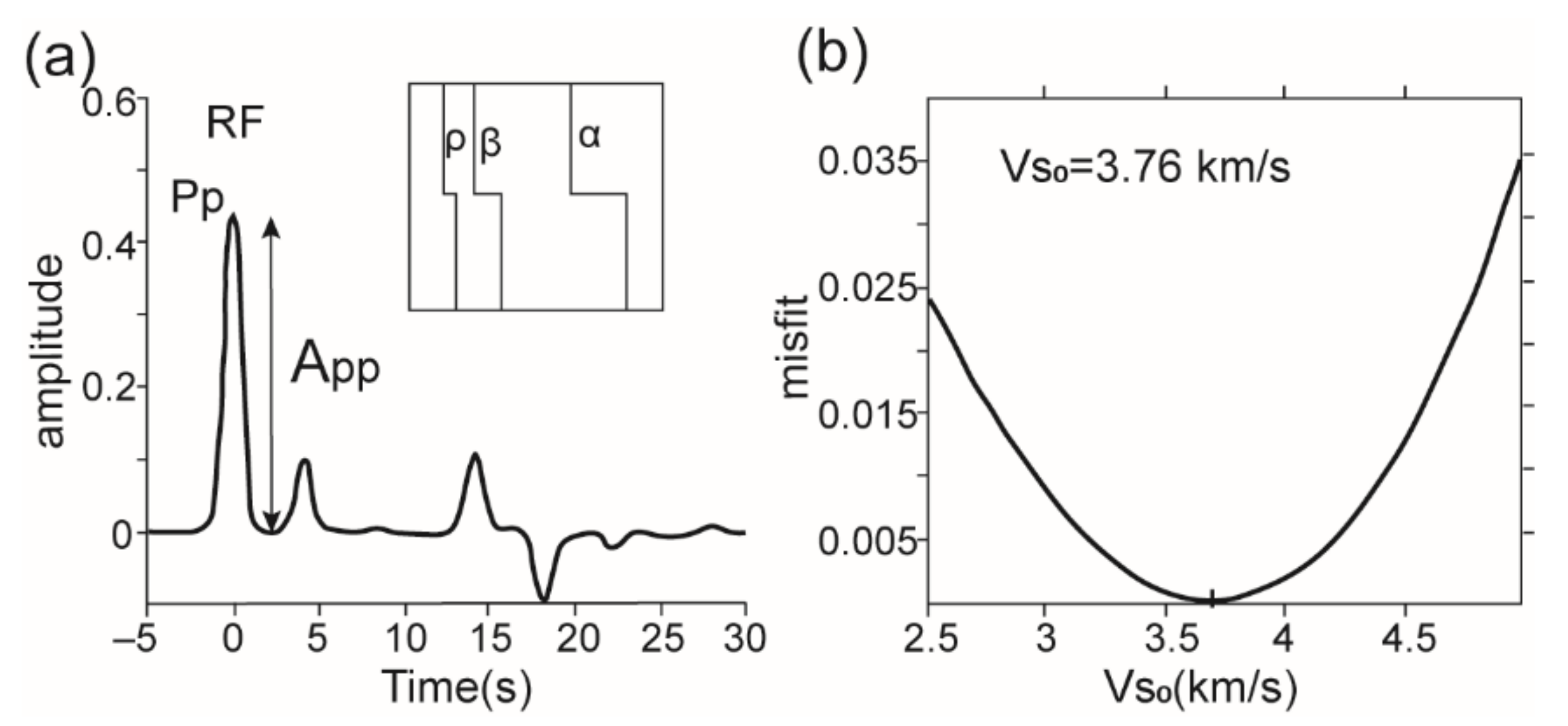
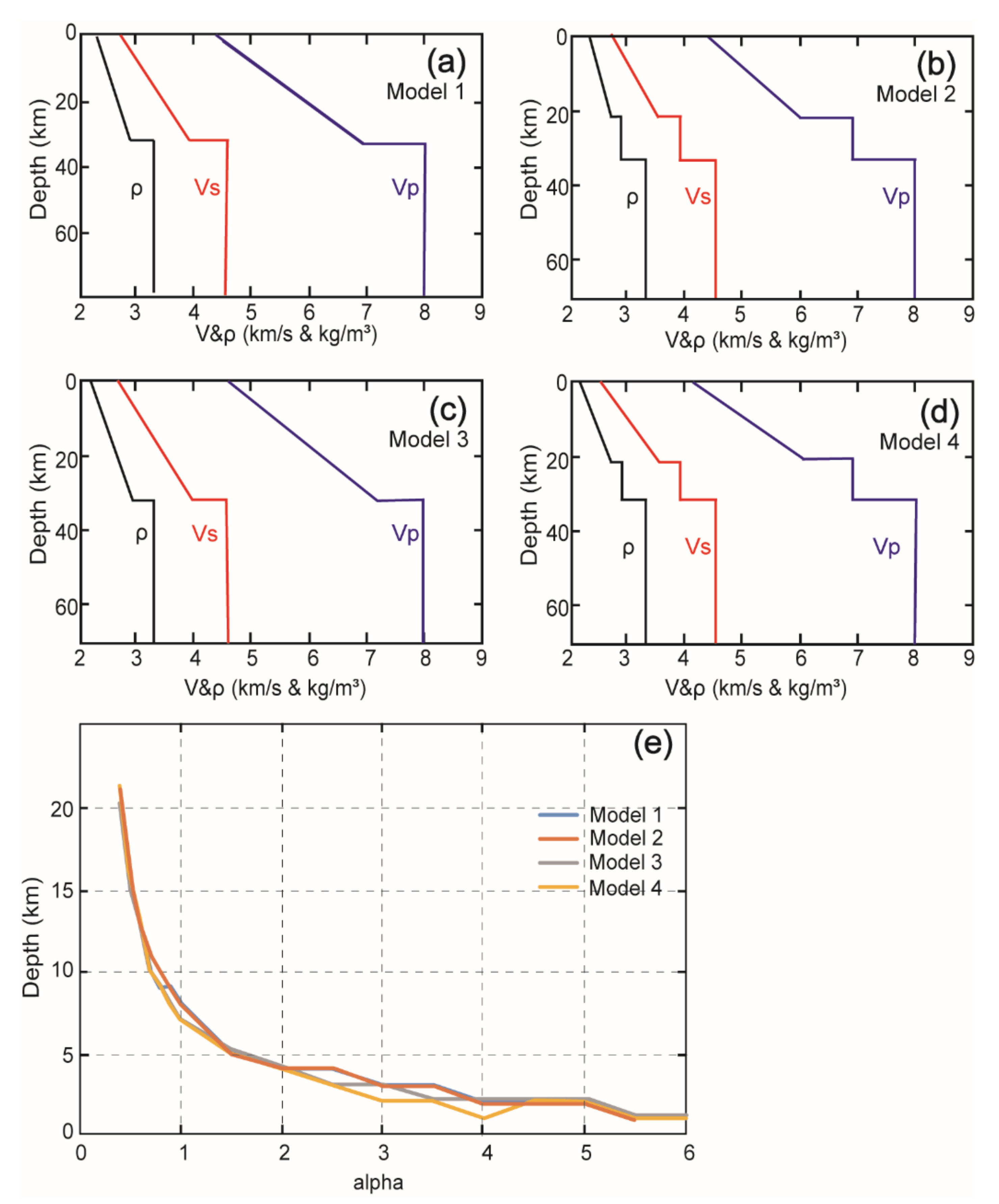
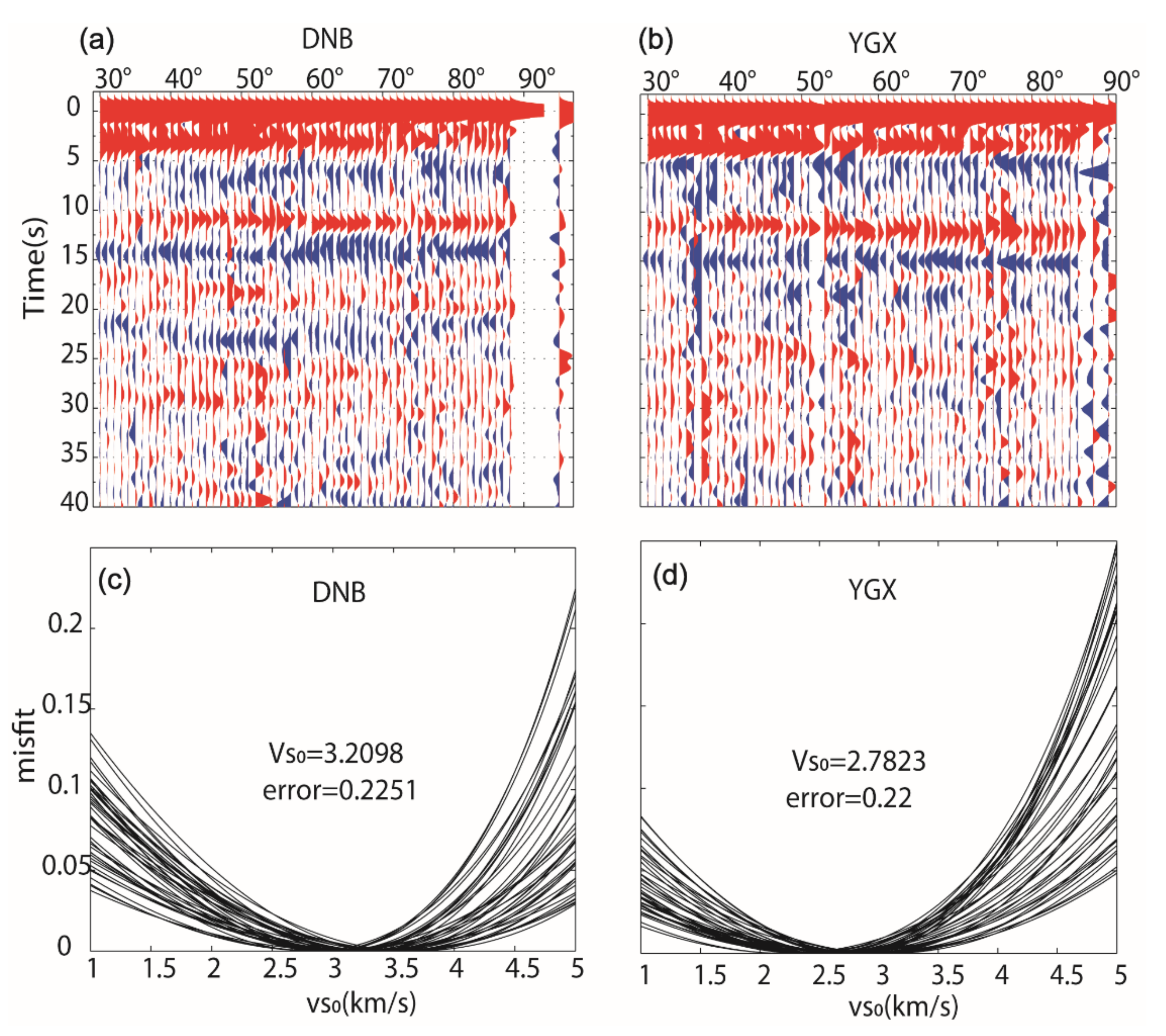
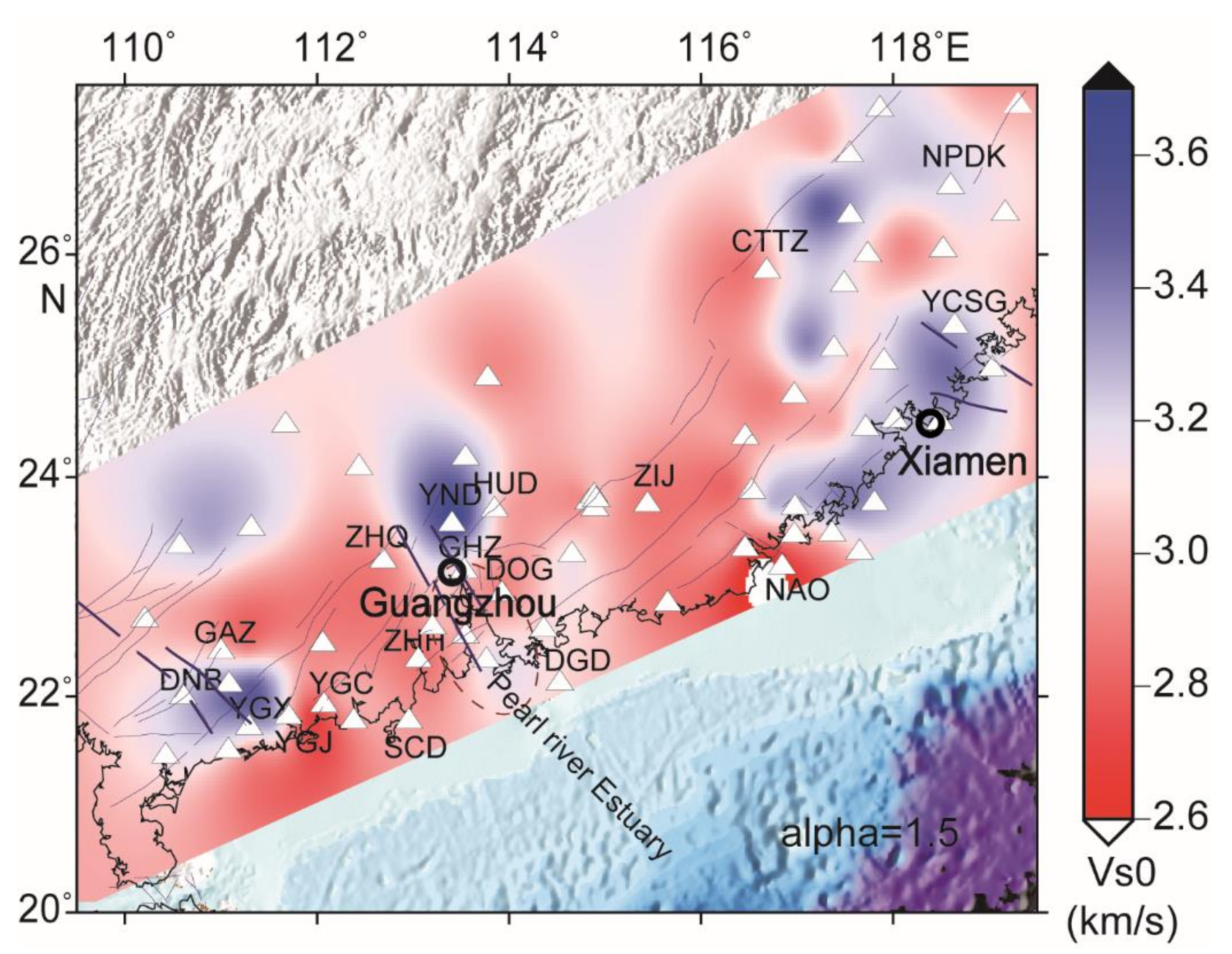

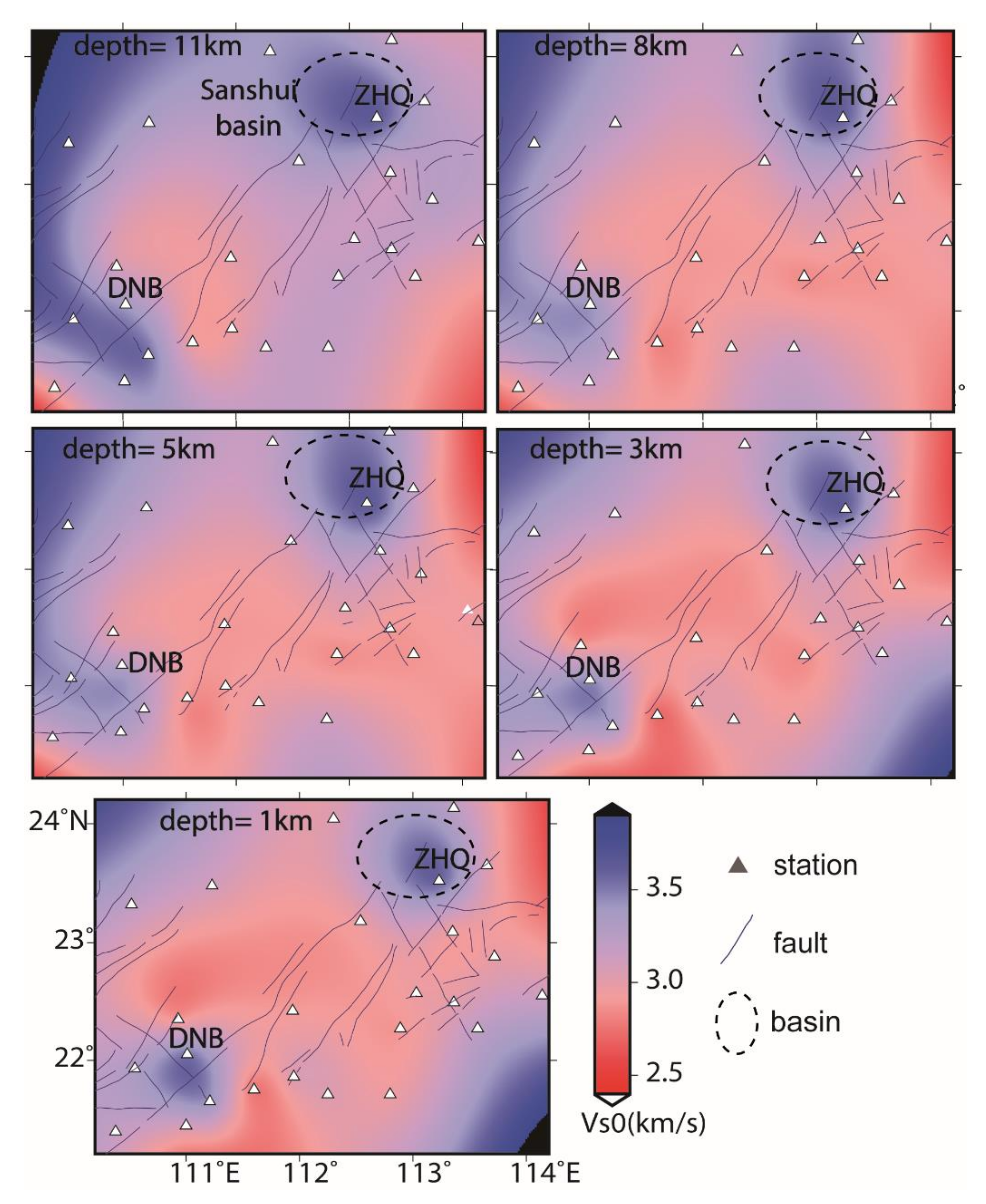
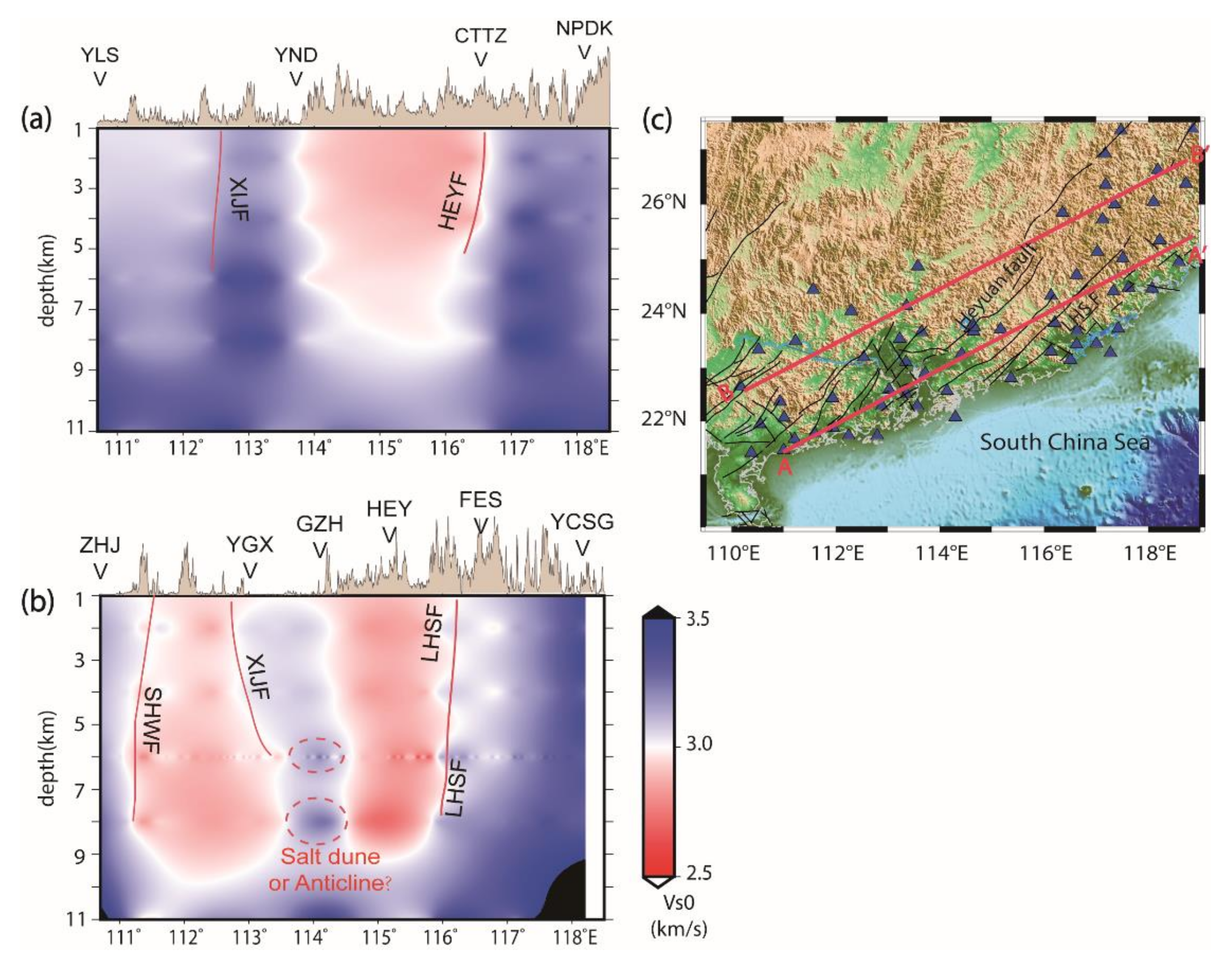
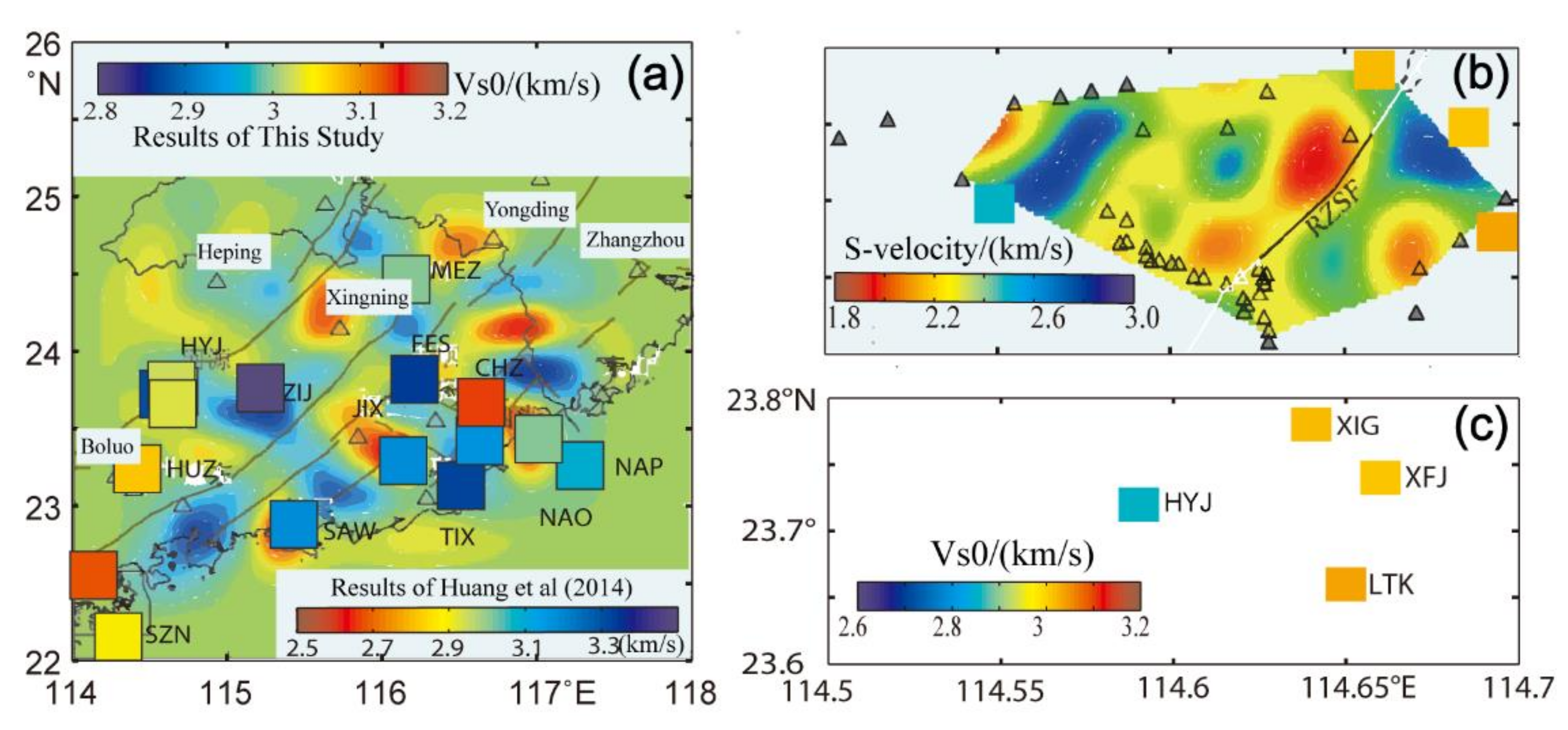
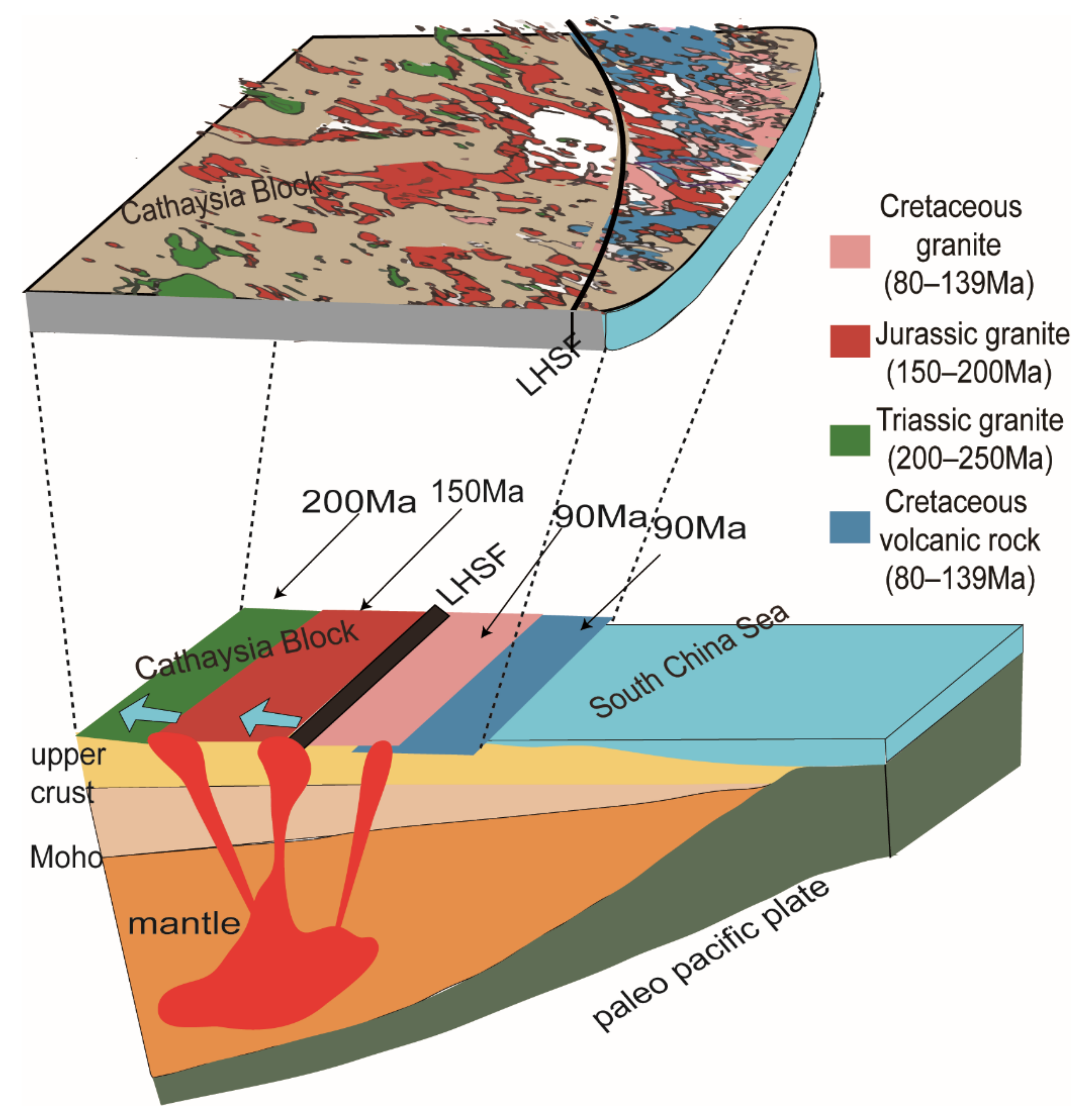
Publisher’s Note: MDPI stays neutral with regard to jurisdictional claims in published maps and institutional affiliations. |
© 2022 by the authors. Licensee MDPI, Basel, Switzerland. This article is an open access article distributed under the terms and conditions of the Creative Commons Attribution (CC BY) license (https://creativecommons.org/licenses/by/4.0/).
Share and Cite
Zhang, X.; Qian, Y.; Shen, X.; Huang, H.; Chai, H. Shallow Crustal Structure of S-Wave Velocities in the Coastal Area of South China Constrained by Receiver Function Amplitudes. Remote Sens. 2022, 14, 2760. https://doi.org/10.3390/rs14122760
Zhang X, Qian Y, Shen X, Huang H, Chai H. Shallow Crustal Structure of S-Wave Velocities in the Coastal Area of South China Constrained by Receiver Function Amplitudes. Remote Sensing. 2022; 14(12):2760. https://doi.org/10.3390/rs14122760
Chicago/Turabian StyleZhang, Xin, Yinping Qian, Xuzhang Shen, He Huang, and Haibin Chai. 2022. "Shallow Crustal Structure of S-Wave Velocities in the Coastal Area of South China Constrained by Receiver Function Amplitudes" Remote Sensing 14, no. 12: 2760. https://doi.org/10.3390/rs14122760
APA StyleZhang, X., Qian, Y., Shen, X., Huang, H., & Chai, H. (2022). Shallow Crustal Structure of S-Wave Velocities in the Coastal Area of South China Constrained by Receiver Function Amplitudes. Remote Sensing, 14(12), 2760. https://doi.org/10.3390/rs14122760




